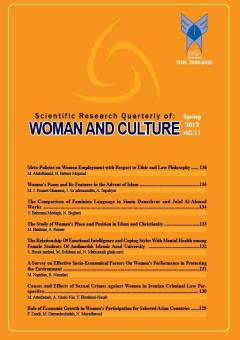Role of Economic Growth in Women's Participation for Selected Asian Countries
Subject Areas : Sociologyفاطمه Zandi 1 , مرجان Damankeshideh 2 , نیلوفر Moradhassel 3
1 - Assistant Professor, Department of Economics, Faculty Member, Islamic Azad University, South Branch, Tehran, Iran.
2 - Assistant Professor, Department of Economics ,Islamic Azad University, Center Branch, Tehran, Iran.
3 - Assistant Professor, Department of Economics ,Islamic Azad University, Center Branch, Tehran, Iran.
Keywords:
Abstract :
Today, due to the economic development and mechanization of production, physical or bodily capacities would not contribute to the development of countries. On the contrary, in many societies women have played a major role in the magnificent growth of economies of their countries, so that from a modern point of view, and for many of the new economics, it is not the sexuality but participation of individuals-disregarding sexuality factor- that determines the merits of women and men. During recent decades the study of the effects of economic and non- economic variables on women activities, has been the agenda of researchers, from which we can point up the effect of economic growth on women’s activities. This was carried out for the first time in 1981 by War. The main point here is that fundamentally, in the early stages of economic growth, the relation between women activities and the economic growth has been negative, but the relation becomes positive for later stages of economic growth. This study tried to test the effect of economic growth on the index of women's participation for selected Asian countries which have different income groups (including Iran). This would be done using the method of Panel data. It was shown that the improvement of two indices: life expectancy and literacy for women would increase the rate of women’s participation. The results showed that there was a U-form relation between women's participation and economic growth.
احمدنیا، شیرین، (1380)."برخی عوامل فرهنگی – اجتماعی مؤثر بر مشارکت محدود زنان"، انجمن جمعیت شناسی ایران، شماره 4.
امین زاده، فرخ، (1358). "جمعیت شناسی کار (منابع انسانی در توسعه)، جلد دوم؛ تهران: انتشارات دانشگاه شهید بهشتی.
توسلی، غلامعباس، (1375). "جامعه شناسی کار و شغل، تهران؛ انتشارات سمت.
رجبی، ماهرخ،(1374). "تحولات تکنولوژی و اشتغال زنان روستایی 65-1345 "، در مجموعه مقالات سمینار بررسی مسائل جمعییتی ایران، جلد اول، شیراز، مرکز جمعیت شناسی دانشگاه.
سخاوت، جعفر، (1380). "وضعیت اشتغال زنان در ایران با تکیه بر اشتغال فارغ التحصیلان مدارس حرفه ای دختران در شهر تهران"، نامه انجمن جامعه شناسی ایرا، شماره 5.
سفیری، خدیجه، (1377). "جامعه شناسی اشتغال زنان"، تهران، مؤسسه فرهنگی-انتشاراتی تبیان.
محمودیان ، حسین (1382). "بررسی مشارکت زنان در نیروی کار در استان ها در سال های 55، 65 و 75"، هفته نامه علوم اجتماعی ، شماره 21.
عظیمی، لیلا، (1380). "بررسی عوامل مؤثر بر مشارکت اجتماعی زنان مطالعه موردی زنان شهر شیراز"، رسالهی کارشناسی ارشد، دانشگاه شیراز.
عمادزاده، مصطفی، (1382). "اهمیت سرمایه گذاری در آموزش زنان"، فصلنامه پژوهش زنان، شماره 7، صص 129-125
Baltagi, Badi H.,(1995). " Economic Analysis of Panel Data". Published by Willy&Sons Ltd.
Basset, P., (1994)."Declining Female Labour Force Participation", Perspective on Labour and Income,Vol. 6, No.2.
Beaudry P. & Lemieux T., (1998). "Evalution of the female labour force participation rate in Canada, 1976-1994: a cohort analysis", National Bureau of Economic Research Working Paper, No.6132.
Cagatay N., Ozler S.,(1995)."Feminisation of the labour force:the effects of long term development and structural adjustment", World Development 23: 1889-1894.
Calan,T. and Wren A.,(1994). "Male – Female Wage Differentials:Analysis and Palicy Issues, General Research Series Paper No.163, Dublin: The Economic and Social Research Institute.
Hardee, Karen, et al (1999). "Family Planning, Work and Women's Economic and Social Autonomy in Indonesia", Asia Pacific Population Journal, Vol.14,No.3.
Kotis,(1990). "Female Entrepreneur's Personal Characteristics and Motivation: a Review of The Greek Situation", women in management Review,Vol.20, pp 24-36.
Ling Y., (2000)." Education , Married Women's Participation Rate, Fertility and Economic Growth", Journal of Economic Development.
Nihar Ranjan Mishra and Sanjay Kumar Mohanty, (2003). "Understanding the Occupational Pattern of Labor Force in States and Districts of India", 2003.
Ware, Helen, (1981). "Women, Demography and Development", Canberra: Australian National University.
World Development Indicators (WDI) data base., 2007.
_||_

